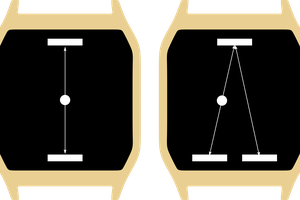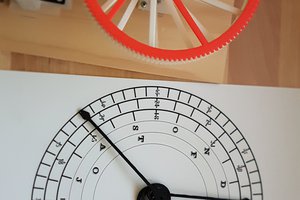OPERATION
Upon power on, the software connects to the local WiFi (more on this topic below) and requests a timestamp from the US National Institute of Science and Technology atomic clock. This accurate timestamp is then used to set and maintain an internal real-time clock. When the user pushes the button (lower left), the servos operate to articulate the fingers and thumbs to sign out the tellers T I M E followed by four digits of the current time (hours and minutes) in a 24 hour format. Many thanks to Chris (The Canadian Maker) for his help in refining the finger movements.
WIFI CONNECTIVITY
To establish WiFi connectivity, my software uses the “WiFiManager” library built for the ESP8266 platform. At power on, an attempt is made to connect to the local WiFi using previously stored channel name and password. If it fails to connect with these credentials, the ESP8266 starts a local server (http://192.168.4.1) prompting the user to select the appropriate WiFi channel (SSID) – selected from a list of found channels – and enter its password. These are then stored in the ESP8266’s EEPROM and the connection re-attempted.
THE MECHANICS
The manikin hand started as a 8″ tall
articulated wooden hand modeled on a ladies left hand and sold for use
by artists as a drawing guide. This wooden hand is sold as making “… a
perfect reference tool. Perfectly proportioned and flexible fingers, the
models are used for study of the human hand and the basic shapes in its
design… ” and is “perfect for helping artists to capture all the
correct scale and shadows for their drawings and artwork”
However, as
all of the finger joints were designed to maintain a pose, they had to
be painstakingly taken apart and adjusted to allow free movement. In
addition, each joint was modified with an additional wedge of wood so
that their range of movement mirrored the human hand. Holes were bored
through the palm of the hand to the base of each finger and thumb and
through each joint. Nylon cord was then threaded from the tip of each
finger, down through each joint and through the hand. In addition, a
strip of stretchy rubber was attached to the back of each finger joint
to pull the finger upright.
CONSTRUCTION
The hand sits atop a box that I designed in SketchUp and cut on my CNC out of 1/4″ plywood. The cords from each of the fingers pass through the top of the box and attach to the horns of high-torque servo motors (MG995) mounted around the periphery of the box. Each servo operates a separate finger and its 180° of rotation produces a range of linear motion of about 2 - 2.5", more than enough to pull a finger from upright to a fully clenched position.
The box is made up of 4 sides that tab together. The top is machined with a groove and attaches to the periphery of the box sides. Refinements to the design included tabs on the sides that connect to a base and a larger clearance hole for the central servo mount. The central servo is mounted from the inside of the box, whereas the other servos mount from the outside. This peripheral arrangement of the servos allows for a more compact layout as the sweep of the servo arms can overlap.





Time On Your Hands: final position of hand on base

 shane kirkbride
shane kirkbride
 M. Bindhammer
M. Bindhammer
 danjovic
danjovic
 Michael Möller
Michael Möller